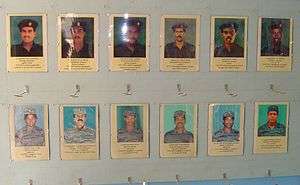Black Tigers
The Black Tigers (Tamil: கரும்புலிகள்) were a wing of the Liberation Tigers of Tamil Eelam (LTTE), a militant Sri Lankan Tamil separatist organization. They were specially selected and trained LTTE cadres whose missions included mounting suicide attacks against military and political targets, among them Sri Lankan President Ranasinghe Premadasa and former Indian Prime Minister Rajiv Gandhi. From their formation in 1987 until the defeat of the Tamil Tigers in 2009, more than 330 Black Tigers made suicide attacks on land and sea, mostly in Sri Lanka.[1]
History

The first Black Tiger was Vallipuram Vasanthan, who drove a small truck laden with explosives into a Sri Lanka Army (SLA) camp in Nelliady, Jaffna peninsula, on 5 July 1987, killing himself and between 39 and 100 Sri Lankan soldiers. Immediately afterwards, regular LTTE cadres followed up, overwhelming the stunned SLA soldiers. This attack was hugely effective, and proved vital in the dismantling of the Sri Lankan Army’s Operation Liberation.[2]
During the earlier phase of the Tamil Tigers’ military campaign, it did not possess the heavy conventional weapons required to attack large camps. To mount such an attack, costly weapons such as artillery pieces, missiles, and fighter-bombers would have been needed – weapons that the LTTE could not afford to purchase. As a result, they decided to resort to asymmetric warfare, creating a special wing to make up for their inadequate weaponry.[2][3] Consequently, it is not the act itself—killing by suicide—that was the Black Tigers' original or even main aim, but rather the military impact and its strategic consequences.[2]
After 18 May 2009, following the death of LTTE leader Velupillai Prabhakaran, the Black Tigers ceased to exist, along with other LTTE fighting formations.
Notable attacks
In May 1991, a woman Tiger who had allegedly been raped by Indian Peace Keeping Force soldiers blew herself up, killing former Indian Prime Minister Rajiv Gandhi, along with 16 civilians. On 1 May 1993, another Black Tiger assassinated Sri Lankan President Ranasinghe Premadasa and 23 others during a May Day parade. On July 2001, 14 Black Tigers attacked Bandaranaike International Airport, causing an estimated of $350 million USD worth of damage to military and civilian aircraft. Tourism in Sri Lanka sharply dropped after the incident.
Black Tigers were drawn from the ranks of the LTTE. Those who wanted to join wrote letters to Velupillai Prabhakaran, the founder and leader of the LTTE. According to the LTTE, Prabhakaran evaluated the applications, examining the applicant's particular skills, the kinds of missions he or she had been involved in, their motivations and their family situations. All these factors were considered in deciding whether he or she could become a Black Tiger. Those who were the only living child in family were automatically disqualified from joining. [4]
Modus operandi

Up to the defeat of LTTE, the Black Tigers carried out 100 to 200 missions. The Black Tigers operated in three distinct ways: conventional combat on land and at sea, guerrilla attacks, and assassinations or bombings. The majority of these attacks involved military objectives in the north and east of the country. Relatively speaking, there were fewer operations in the south, where most of the Sinhalese live, especially in the capital city, Colombo, although such attacks often engaged high-profile targets and attracted much international publicity as a result. The last such attack was on government politicians during a Muslim festival.[2]
References
- ↑ A total of 322 Black Tigers have been killed in action from Captain Miller's death in 1987 until 30 June 2007, according to the Tamil Eelam Heroes Secretariat in Vanni.
- 1 2 3 4 Gambetta, D. (2005). Making sense of suicide missions. Oxford; New York: Oxford University Press. p. 50. ISBN 978-0-19-927699-8.
- ↑ Schalk, P. (1997). "Resistance and Martyrdom in the Process of State Formation of Tamililam". Martyrdom and Political Resistance: 61–83.
- ↑ De Figueiredo Jr, R.J.P.; Weingast, B.R. (2001). "Vicious Cycles: Endogenous Political Extremism and Political Violence. Institute of Governmental Studies Working Paper, 2001-9". University of California, Berkeley.
Further reading
- Balasingham, Anton. (2004) War and Peace – Armed Struggle and Peace Efforts of Liberation Tigers, Fairmax Publishing Ltd, ISBN 1-903679-05-2
- Narayan Swamy, M. R. (2002) Tigers of Lanka: from Boys to Guerrillas, Konark Publishers; 3rd ed. ISBN 81-220-0631-0
- Pratap, Anita. (2001) Island of Blood: Frontline Reports From Sri Lanka, Afghanistan and Other South Asian Flashpoints. Penguin Books, ISBN 0-14-200366-2
- de Votta, Neil. (2004) Blowback: Linguistic Nationalism, Institutional Decay, and Ethnic Conflict in Sri Lanka. Stanford University Press, ISBN 0-8047-4924-8
- Pape, Robert A. (2005) Dying to Win : The Strategic Logic of Suicide Terrorism. Random House. ISBN 1-4000-6317-5
- Sri Kantha, Sachi (2005) Pirabhakaran Phenomenon, Lively COMET Imprint, ISBN 1-57087-671-1
External links
- Alex Perry (12 May 2006). "How Sri Lanka's Rebels Build a Suicide Bomber". Time magazine.
- Frances Harrison (26 November 2002). "'Black Tigers' appear in public". BBC News.
- Sudha Ramachandran (10 July 2004). "Tigers send a deadly message". Asia Times Online.
- www.aruchuna.net/details.php?image_id=2780 Photograph of "Captain Miller", the first LTTE suicide bomber